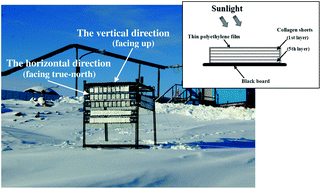Collagen sheets were used in a unique evaluation method to examine skin damage caused by ultraviolet (UV) light of short wavelength during a season of the Antarctic ozone hole. The collagen sheets were exposed outdoors for 25 and 50 d, in the spring when the ozone hole was formed and in the ozone-hole-free autumn. Extracts from the exposed collagen sheets were analyzed for total protein and terminal amino acid concentrations as an index of collagen fragmentation. The results show that the amount of extractable collagen and terminal amino acid concentration in the spring exposure were approximately double and five times higher, respectively, when compared with those in the autumn exposure. During the ozone hole occurrence, the terminal amino acid concentration of the extracted collagen was about five times higher when exposure lasted 50 d from mid-September to the end of October compared to when exposure lasted 25 d from mid-September to early October. This result could be attributed to a limited amount of short-wavelength UV radiation reaching the ground surface as a result of the low height of the sun in September, when the ozone hole occurred. In fact, UV radiation measurements taken at Syowa Station indicate that short-wavelength UV radiation in the range 290–295 nm was not detected until approximately 1–2 months after the beginning of the ozone hole occurrence.

You have access to this article
 Please wait while we load your content...
Something went wrong. Try again?
Please wait while we load your content...
Something went wrong. Try again?


 Please wait while we load your content...
Please wait while we load your content...